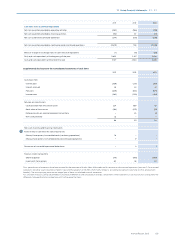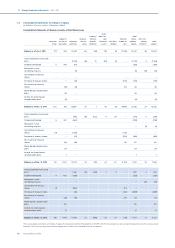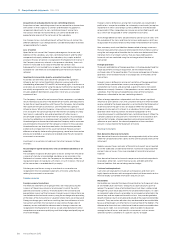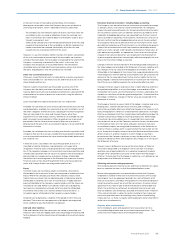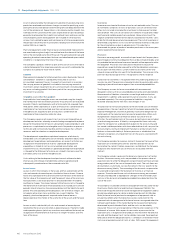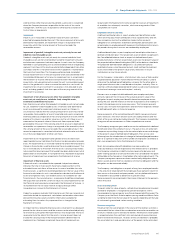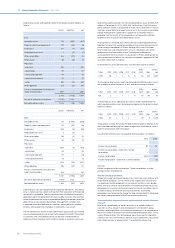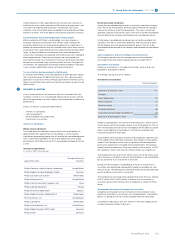Philips 2013 Annual Report Download - page 144
Download and view the complete annual report
Please find page 144 of the 2013 Philips annual report below. You can navigate through the pages in the report by either clicking on the pages listed below, or by using the keyword search tool below to find specific information within the annual report.
11 Group financial statements 11.9 - 11.9
144 Annual Report 2013
recycled in the future. The application of this amendment impacts
presentation and disclosures only. Comparative information has been re-
presented.
IAS 19 Employee Benefits (2011)
As a result of the introduction of IAS 19 (2011) - or IAS 19R/Revised - the
Company has changed its accounting policy with regard to the accounting
of defined benefit pension plans. The main change impacts the basis of
determining the income or expense for the period related to these pension
plans. Under the new standard the Company determines a net interest
expense (income) by applying the discount rate used to measure the
defined benefit obligation (DBO) at the beginning of the annual period to
the net defined benefit liability (asset) at the beginning of the annual
period, taking into account any changes in the net defined benefit liability
(asset) during the period as a result of contributions and benefit payments.
As a result, this net interest now comprises:
• interest cost on the DBO;
• interest income on plan assets; and
• interest on the eect of the asset ceiling.
Previously, the Company determined interest income on plan assets
based on their long-term rate of expected return. Furthermore, as from
January 1, 2013 the Company presents net interest expenses related to
defined benefits in Financial income and expense rather than Income from
operations.
The new standard no longer allows for accrual of future pension
administration costs as part of the DBO. Such costs should be expensed as
incurred. Previously, for the Dutch pension plan the Company accrued a
surcharge for pension administration costs as part of the service costs into
the DBO. With the adoption of the new standard this accrual was
eliminated, resulting in an exclusion of EUR 216 million from the DBO per
January 1, 2013, thereby improving the funded status. This funded status
improvement is oset by the impact of the asset ceiling test regarding the
Dutch pension plan’s surplus, and hence there is no further impact on the
Company’s balance sheet figures other than the direct recognition of
previously unrecognized past service cost.
The impact on Equity from the IAS 19 (2011) accounting policy change is as
follows:
December 31,
2012
Decrease in the net defined benefit obligation
(non-current, after asset ceiling restriction) 13
Increase in deferred tax assets (non-current) (2)
Net increase on equity 11
Split to:
Equity holders of the parent 11
Non-controlling interest –
The limited impact on the balance sheet mainly relates to some
unrecognized past service cost gains and losses which must be recognized
immediately under IAS 19 (2011). The limited impact is explained by the
fact that the Company already applied immediate recognition of actuarial
gains and losses in Other comprehensive income.
The negative impact of IAS 19 (2011) for post-employment defined benefit
plans on Income from operations, Income before taxes and Basic and
Diluted earnings per share is as follows:
2011 2012
Income from operations (124) (260)
Financial income and expenses (92) (85)
Income before taxes (216) (345)
Basic earnings per share (0.17) (0.28)
Diluted earnings per share (0.17) (0.28)
Recoverable Amount Disclosures for Non-Financial Assets
(Amendments to IAS 36) (2013)
The amendment to IAS 36 Impairment of Assets was introduced following
the introduction of IFRS 13 Fair Value Measurement, to reduce the
circumstances in which the recoverable amount of assets or cash-
generating units is required to be disclosed, clarify the disclosures
required, and to introduce an explicit requirement to disclose the discount
rate used in determining impairment (or reversals) where recoverable
amount (based on fair value less costs of disposal) is determined using a
present value technique. As the amendment is basically to avoid
unintended disclosure requirements from the introduction of IFRS 13, it
was early adopted by the Company. The amendment has no material
impact.
Defined Benefit Plans: Employee Contributions (Amendments to IAS 19)
Initially the abovementioned IAS 19 (2011) adjustments required that
employee contributions basically would have to be incorporated in the
measurement of the defined benefit obligation. This amendment allows a
practical expedient to continue to recognize employee contributions in
the Statement of income when certain conditions are met. The Company
early adopted this amendment and as a result there is no change in the
way how employee contributions are currently treated compared to the
treatment prior to the IAS 19 (2011) adoption. Up to 2013 the Company has
very limited employee contributions in their pension plans.
IFRS accounting standards adopted as from 2014 and onwards
A number of new standards and amendments to existing standards have
been published and are mandatory for the Company beginning on or after
January 1, 2014 or later periods, and the Company has not yet early
adopted them. Those which may be the most relevant to the Company are
set out below.
IFRIC 21 Levies
IFRIC 21 provides guidance on the accounting for certain outflows
imposed on entities by governments in accordance with laws and/or
regulations (levies). The Interpretation identifies the obligating event for
the recognition of a liability as the activity that triggers the payment of the
levy in accordance with the relevant legislation. This Interpretation does
not have a material impact on the financial statements.
Changes to other standards, following from Amendments and the Annual
Improvement Cycles, do not have a material impact on the Company’s
financial statements.



